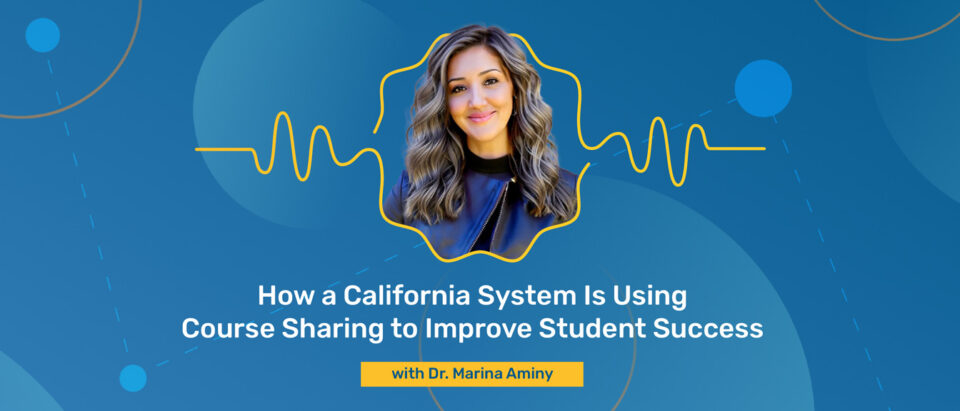
Course sharing has quickly become a game-changer for boosting leaner success across educational institutions. Dr. Marina Aminy, Executive Director of California Virtual Campus and Associate Vice Chancellor at Foothill-De Anza Community College District, has been at the forefront of this initiative in the California Community College System (CCCS). In a recent Parchment podcast, Dr. Aminy delved into the significance of course sharing and its transformative impact on learners, particularly in a state as expansive as California.
Beyond Campus Limits: How Course Sharing Transforms Student Access
Simply put, course sharing refers to the idea that learners are no longer confined to the offerings of their home institution when pursuing their academic goals. Traditionally, learners enrolled in a specific college are limited to the courses available within that institution’s portfolio. This restriction can slow down their progress, especially when essential courses are out of reach. That’s where course sharing steps in — giving learners the flexibility to enroll in courses across a network of institutions, hassle-free.
In the context of the CCCS, which comprises 116 colleges, course sharing unlocks a world of possibilities. According to Dr. Aminy, “The idea of course sharing is sort of what would happen if we opened up the walls of our class schedule to allow students to take classes seamlessly and easily at any of the other institutions in our consortium or system.” This streamlined process — one without secondary applications or bureaucratic hurdles — is particularly beneficial for learners who need specific courses to graduate or transfer to four-year institutions but can’t find them at their home college.
Course Sharing in Practice: A Personal Story of Academic Success
Dr. Aminy shared some powerful stories showing just how transformative course sharing can be for students. Take her own son, for instance. He’d been accepted to a four-year college but “his admission to that four-year institution was conditional on him completing a second semester of calculus. And he had no option because his current school didn’t offer any more classes. They were done.” This meant that he was at risk of losing his spot. Fortunately, Dr. Aminy tells us, “he was able to go use the exchange, which is what we call our course-sharing platform, and look for a calculus class that was being offered at another district that had a quarter system.” As a result, he successfully completed the calculus class and secured his admission.
Cases like this underscore how course sharing can adapt to diverse needs — whether for working adults, caregivers, or individuals with disabilities. That way, every learner has the opportunity to succeed academically, regardless of their circumstances.
How Course Sharing Expands Educational Access
One of the standout features of the CCCS course-sharing initiative is the sheer scale of its implementation. With 116 colleges collectively offering around 350,000 courses each year, learners are given unprecedented access to educational resources. This broad reach means students don’t have to hit pause on their education just because a course isn’t available at their home college.
The best part? Cross-enrollment through this course-sharing platform is designed to be quick and straightforward. As Dr. Aminy pointed out, “Cross-enrollment takes around two minutes on the platform, made possible by Parchment…versus the months and months and months that they’re typically waiting for answers and provisioning.” This is a far cry from the old, clunky process of applying to multiple colleges, waiting for decisions, and navigating a maze of onboarding steps. By eliminating these barriers, course sharing fosters a learner-centered approach that prioritizes learners’ needs and success.
Addressing Retention and Revenue Concerns
A common concern among colleges regarding course sharing is the potential loss of learners to other institutions, which could impact enrollment numbers and, subsequently, revenue. Dr. Aminy recognized these concerns but backed them up with some reassuring data. “We’ve had over 11,500 enrollments this year in the system…over 80% of those have been single-course enrollments. This indicates that, hey, students truly are using cross-enrollment for that one thing that they need, or that one class that they need,” she explains. At the time of publication, that number has grown to more than 17,000 enrollments. Simply put, learners aren’t abandoning their home colleges but rather leveraging course sharing to fill gaps in their education.
To address these worries, the CCCS has put policies in place to ensure that all stakeholders see the advantages of course sharing. In fact, Dr. Aminy emphasizes that “It’s truly an exchange in the sense that both home colleges and teaching colleges benefit.” For example, learners have to be active at their home college to use course sharing, and colleges get funding based on enrollments and course completions. This setup makes sure that financial incentives are aligned, encouraging colleges to embrace course sharing without the fear of losing out.
The Future of Course Sharing: Expanding Horizons
Looking ahead, Dr. Aminy envisions even broader applications of course sharing. She’s imagining a future where this model expands beyond the CCCS to include the University of California (UC) and California State University (CSU) systems. This would create a more integrated educational experience, allowing learners to seamlessly continue their learning journey. “I think it’s very, very powerful for students to have this singular journey in their education from elementary school through their career,” she highlighted.
The ultimate goal is to create a unified learning experience where learners can access the courses they need, regardless of geographic location, and carry their records and credentials with them throughout their educational journey. This approach would not only broaden access to education but also better prepare learners for the evolving demands of the workforce.
Support a Learner-Centered Approach to Education
Course sharing represents a significant shift in how educational institutions can collaborate to meet the needs of learners today. By breaking down the barriers that traditionally confine learners to a single college’s offerings, learners in the CCCS now have access to a world of courses across different institutions. This is paving the way for a more flexible, accessible, and learner-centered approach to education.
According to Dr. Aminy, “Course sharing is the future. And I think if colleges and systems want to get on board, it can only be good for students…the possibilities are endless because in setting up that network and system of APIs between the colleges, you can expand it to include a lot.”
Interested in learning more? Listen to the full podcast here or explore Parchment Course Sharing to learn how you can leverage the power of your state system or consortium to better meet the needs of your learners.
There’s always more to learn.
Ready to feel the power of Parchment?
I’m a student or a learner
OrderI work at an institution or business
Get a Demo
